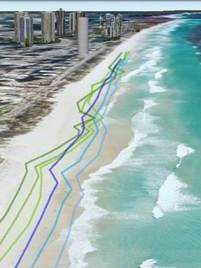New research reducing the impact of extreme events

Source: TERN newsletter
Australia has always been a country of extremes. As a consequence Australian ecosystems – and the communities and industries that depend upon them – are, on the whole, a pretty resilient lot. But with all indicators pointing to likely increases in frequency and/or intensity of extreme events such as drought, heatwaves, bushfires, cyclones and floods in coming decades, is this resilience at risk?
The Commonwealth Science Council clearly thinks so, citing tens of billions of dollars in economic cost to the country due to extreme events in recent years, and identifying research into mitigation, management or adaptation as a National Science and Research Priority.
Science can’t prevent extreme events. But good ecosystem science – underpinned by collaborative research infrastructure such as that being delivered through TERN – is a demonstrably cost-effective way to increase our understanding of the complexities of their impacts, and therefore better inform preparedness and adaptation by communities, industries and management agencies.
An example of how TERN’s capabilities are being used: Improving understanding of extreme coastal events
Some of the ways in which TERN’s nationally networked capabilities are already being wielded by scientific and management agencies across the country in the context of extreme events can be seen in a series of public presentations that are now freely available online. More details about some of these capabilities can be found below:
A watchful eye on Australia’s fires.
A new wave of advancements in remote-sensing technologies delivered through TERN’s AusCover Facility is providing more accurate, up-to-date information about the environmental variables that influence fire risk, and improving stakeholders’ ability to remotely-track fires near and far.
Improving understanding of extreme coastal events.
We Australians prize our coastlines. Yet agencies responsible for managing these dynamic ecosystems frequently struggle to access the data and infrastructure they need to prepare for and learn from storm surges, flooding and erosion events. TERN’s Coasts Facility is here to help.
Hot on the trail of heatwaves.
Seems like nearly every year now kicks-off with record-breaking heatwaves across the southern half of the country. A team of researchers is using the datasets now being collected and delivered through TERN’s OzFlux Facility to investigate heatwave impacts on Australian ecosystems.
Windy weather – dusty days ahead?
Dust storms can be bad news for human health, ecosystems, agriculture, transport, infrastructure and ultimately our economy. TERN and CSIRO are contributing to the national DustWatch program to help improve both community and scientific understanding of the risks.
Science improves cyclone resilience in the Wet Tropics.
Cyclones wreak havoc in northern Australia every summer, risking lives and damaging homes, crops and businesses, as well as having dramatic impacts on natural environments. Ecosystem science has helped improve the resilience of FNQ’s ecosystems, communities and industries such as agriculture and tourism.
Ecosystem resilience to drought across the globe.
Using TERN infrastructure to participate in a recent Nature-published study of global droughts, local researchers found evidence that Australia’s grassland ecosystems – and in turn our agricultural and grazing sectors – may be among our most sensitive to predicted changes in climate.
The erratic greening of arid Australia.
Long-term observers and residents of arid Australia know that the region’s transformative rhythms reflect extremes of climatic conditions rather than seasons, and are characterised by irregular pulses of productivity that punctuate long periods of drought.
Connecting cyclones and carbon emissions in our northern savannas.
Surprisingly little is known about how cyclones affect one of Australia’s most extensive ecosystems, tropical savannas. A recently-published collaborative study took advantage of TERN’s infrastructure to investigate and made some fascinating discoveries.
Published in TERN newsletter April 2015

